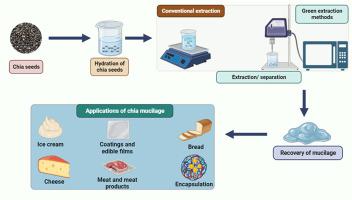当前位置:
X-MOL 学术
›
Food Hydrocoll.
›
论文详情
Our official English website, www.x-mol.net, welcomes your feedback! (Note: you will need to create a separate account there.)
Evaluation of extraction techniques for chia seed mucilage; A review on the structural composition, physicochemical properties and applications
Food Hydrocolloids ( IF 10.7 ) Pub Date : 2024-03-30 , DOI: 10.1016/j.foodhyd.2024.110051 Emmanuel O. Mensah , Emmanuel O. Oludipe , Yemane H. Gebremeskal , Liudmila A. Nadtochii , Denis Baranenko
Food Hydrocolloids ( IF 10.7 ) Pub Date : 2024-03-30 , DOI: 10.1016/j.foodhyd.2024.110051 Emmanuel O. Mensah , Emmanuel O. Oludipe , Yemane H. Gebremeskal , Liudmila A. Nadtochii , Denis Baranenko

|
Plant polysaccharides such as mucilage obtained from seeds, roots, branches, and leaves have gained significant interest in the food and pharmaceutical industries due to their rich chemical, functional and biological properties. Chia seeds which are rich in fiber, proteins, polyunsaturated fatty acids, and minerals are capable of producing mucilage upon hydration in water. The process of obtaining chia mucilage is rather simple involving three different stages, namely; hydration, extraction, and recovery. However, in conventional treatment, incomplete removal or detachment of the mucilage from chia seeds occurs, which tends to reduce its yield, and thus hinders its application. In addition, extraction parameters such as time, temperature, and water-to-seed ratio affect the yield and quality of chia mucilage. Alternative and emerging extraction technologies have been reported to produce mucilage with tailored properties. As such, this review discusses different emerging extraction technologies of obtaining chia mucilage, mainly ultrasound-assisted and microwave-assisted extraction, and their influence on the yield and functional properties of chia mucilage. This poses a greater diversity of applications of chia mucilage including fat/egg replacers, gluten-free products, carrier-based systems (micro- and nanoparticles, coatings, and edible films), and stabilizers. Although, many studies have been reported on its applications, nevertheless, studies related to improving the sensory profile of these products as well as information regarding their safety are important to attract consumers.
中文翻译:

奇亚籽粘液提取技术的评价;结构组成、理化性质及应用综述
植物多糖,例如从种子、根、树枝和叶子中获得的粘液,由于其丰富的化学、功能和生物特性而在食品和制药行业中引起了极大的兴趣。奇亚籽富含纤维、蛋白质、多不饱和脂肪酸和矿物质,在水中水合后能够产生粘液。获得奇亚籽粘液的过程相当简单,涉及三个不同的阶段,即:水合、萃取和回收。然而,在常规处理中,奇亚籽的粘液去除不完全或脱落,这往往会降低奇亚籽的产量,从而阻碍其应用。此外,时间、温度和水与种子的比例等提取参数也会影响奇亚籽粘液的产量和质量。据报道,替代和新兴的提取技术可以生产具有定制特性的粘液。因此,本文讨论了获得奇亚籽粘液的不同新兴提取技术,主要是超声波辅助和微波辅助提取,及其对奇亚籽粘液的产量和功能特性的影响。这使得奇亚籽粘液的应用更加多样化,包括脂肪/鸡蛋替代品、无麸质产品、基于载体的系统(微米和纳米颗粒、涂层和可食用薄膜)和稳定剂。尽管已经报道了许多关于其应用的研究,但是,与改善这些产品的感官特征以及有关其安全性的信息有关的研究对于吸引消费者非常重要。
更新日期:2024-03-30
中文翻译:

奇亚籽粘液提取技术的评价;结构组成、理化性质及应用综述
植物多糖,例如从种子、根、树枝和叶子中获得的粘液,由于其丰富的化学、功能和生物特性而在食品和制药行业中引起了极大的兴趣。奇亚籽富含纤维、蛋白质、多不饱和脂肪酸和矿物质,在水中水合后能够产生粘液。获得奇亚籽粘液的过程相当简单,涉及三个不同的阶段,即:水合、萃取和回收。然而,在常规处理中,奇亚籽的粘液去除不完全或脱落,这往往会降低奇亚籽的产量,从而阻碍其应用。此外,时间、温度和水与种子的比例等提取参数也会影响奇亚籽粘液的产量和质量。据报道,替代和新兴的提取技术可以生产具有定制特性的粘液。因此,本文讨论了获得奇亚籽粘液的不同新兴提取技术,主要是超声波辅助和微波辅助提取,及其对奇亚籽粘液的产量和功能特性的影响。这使得奇亚籽粘液的应用更加多样化,包括脂肪/鸡蛋替代品、无麸质产品、基于载体的系统(微米和纳米颗粒、涂层和可食用薄膜)和稳定剂。尽管已经报道了许多关于其应用的研究,但是,与改善这些产品的感官特征以及有关其安全性的信息有关的研究对于吸引消费者非常重要。



























 京公网安备 11010802027423号
京公网安备 11010802027423号